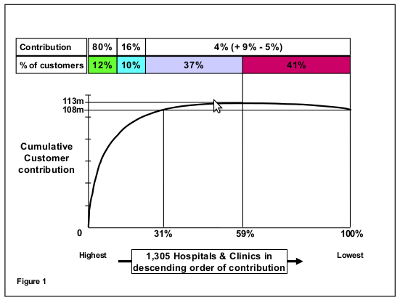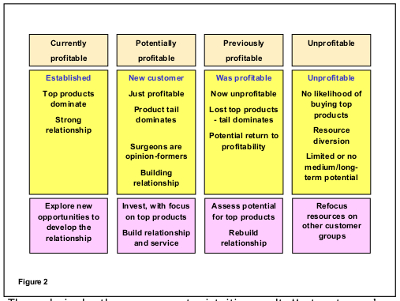Improving customer profitability
A global manufacturer and supplier of orthopaedic implants and surgical instrumentation had manufacturing plants in two European countries with sales via a single European distribution centre. Their product portfolio contained over 1,300 appliances and instruments. Some product ranges were based on the latest available materials and surgical know-how, but there existed a long tail of small-batch items, mainly based on older, superseded technology.
Contribution categories
The first phase of an Activity Based Costing (ABC) project determined the real contribution that each product made. None were negative though the activity based costs of all the mainstream products were significantly lower than previously thought, while those of the tail products were generally slightly higher.
Based on the analysis, the product groups were categorised into Gold (the highest contributing products that together made 70% of the total contribution), Silver (20%) or Red (the final 10%).

The second phase of the analysis determined the real contribution made by each customer. Figure 1 shows the cumulative contribution of customers ranked in the sequence from the highest being the first on the left to the lowest being the last on the right.
Based on contribution the customers were categorised as Green, Blue, Grey or Purple.
Because customer-driven costs were relatively low, customer profitability correlated very closely with the products that they bought. Green customers bought predominantly Gold products; Blue customers bought similar quantities of all product groups, while Grey and Purple customers bought mainly the tail of Red products.
Following the analysis the company was heartened to discover that at least 59% of the customers were profitable with the rest making a hidden loss of only £5 million.
They were anxious to improve their profitability despite the continuing erosion of gross margins in their longer established products, and their competitors’ apparent willingness to provide a superior service to their own customers at no extra cost. They needed to understand the cost implications of matching their competitors’ actions, and to find the most favourable product ranges in which to focus future development.
Designing a profit improvement strategy
The previous custom and practice for the sales force was to share their time across customers and in many cases biasing their sales time towards the higher volume customers.
The ABC analysis showed that the single highest contributing customer out of a customer base of 1,305 gave a contribution equal to the sum of the contributions of the tail of 1,005 customers. To lose any of the highest contributing customers would have created a desperate position for the company. This was the first alert to management to change the use of the sales force’s time.
From a product perspective the implication for a selling strategy seemed simple: focus on new, high-margin ‘gold’ products. This was complicated by the preferences of different customer groups.
One reported risk was that newer products lacked the decades of clinical history which surgeons were said to insist upon. But in other cases some surgeons were keen to be fitting the latest spare parts to patients and to partake in product development. The clear message was that it was vital to really understand customer needs and preferences on an individual basis.
The ‘Red’ tail products though low in contribution terms were nonetheless important, according to the sales force, because many customers would only buy from a ‘one-stop-shop’ that stocked a complete range. Some of the ‘Red’ products also had a valuable role as a low-cost, low-risk introduction route for new customers.
The strategy for ‘Grey’ customers therefore depended on their potential for becoming advocates in the longer term while the loyalty of ‘Green’ and ‘Blue’ customers had to be nurtured and developed.

An overall strategy for the sales force was developed, as shown in Figure 2.
The analysis also threw up a counter intuitive result. Most customers’ demands, as it transpired, drove far less cost than was thought. This revelation changed management’s whole view of the role of the sales force.
For example, ‘in-theatre’ training on the use of the products, in the past seen as a distraction on the salesforce’s time, now came to be viewed as a core service.
Customers who had previously been perceived as abusing this service by using salespeople as unpaid ancillary staff were in the main perfectly willing to pay a reasonable charge. This led to the formation of a team of dedicated theatre support staff, an action that created further advocacy and importantly was the main factor in locking out competitors.
The global picture
Confident in the outcome from the ABC analysis so far, the company then turned its mind to the global picture. Here lay the greatest paradox. Products were manufactured in many locations around the world, and passed through a regional, then a national warehouse en route to the customer. Yet the most profitable customer lay within a stone’s throw of the factory making the most profitable products. This finding led to a root and branch review of the objectives, the performance and indeed the relevance of the global distribution system. The ABC team sharpened their pencils and set to on what was to become the project with the greatest positive impact on corporate results that the company had ever known.
The future – innovation
Now that senior management was free from the relentless pressure arbitrarily to cut costs, it found time to consider innovative ideas to ensure the success of the business in the longer term. Management used ABC to model new scenarios so it could consider manufacturing implants to order, and delivering them just in time. It proposed to provide instrumentation that would be specific to the patient need, maintain a world-wide centre of excellence in reconstructive orthopaedic surgery, and provide in-theatre expert advice personally or remotely by video link and the Internet. With the help of technology it also proposed to maintain a database of clinical history – ‘knowledge management’- on behalf of its customers.


ABC analysis showed that the single highest contributing customer out of a customer base of 1,305 gave a contribution equal to the sum of the contributions of the tail of 1,005 customers.